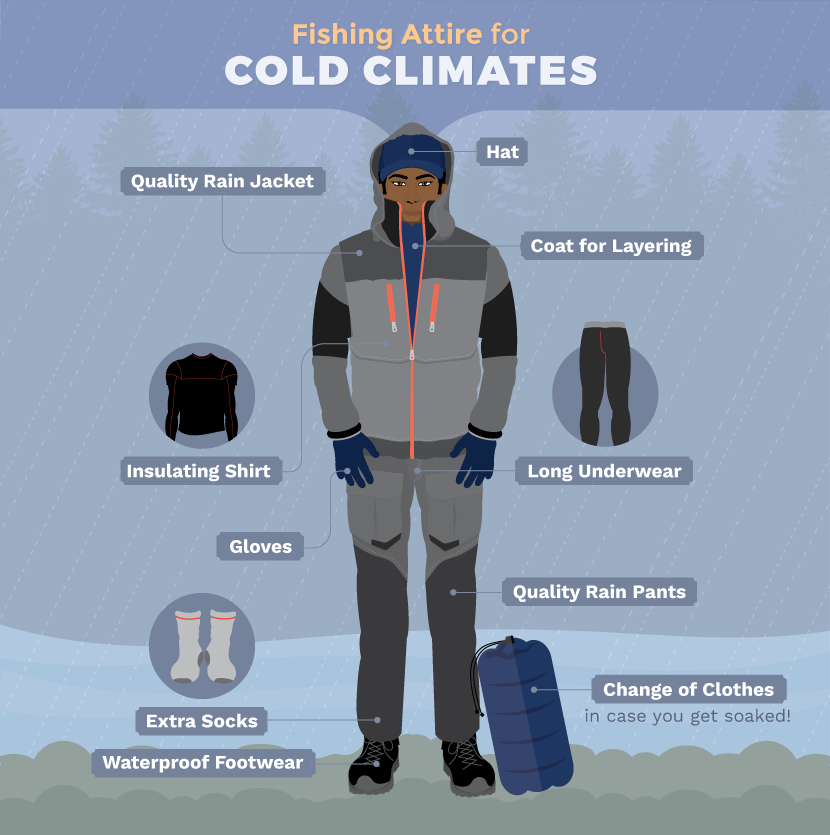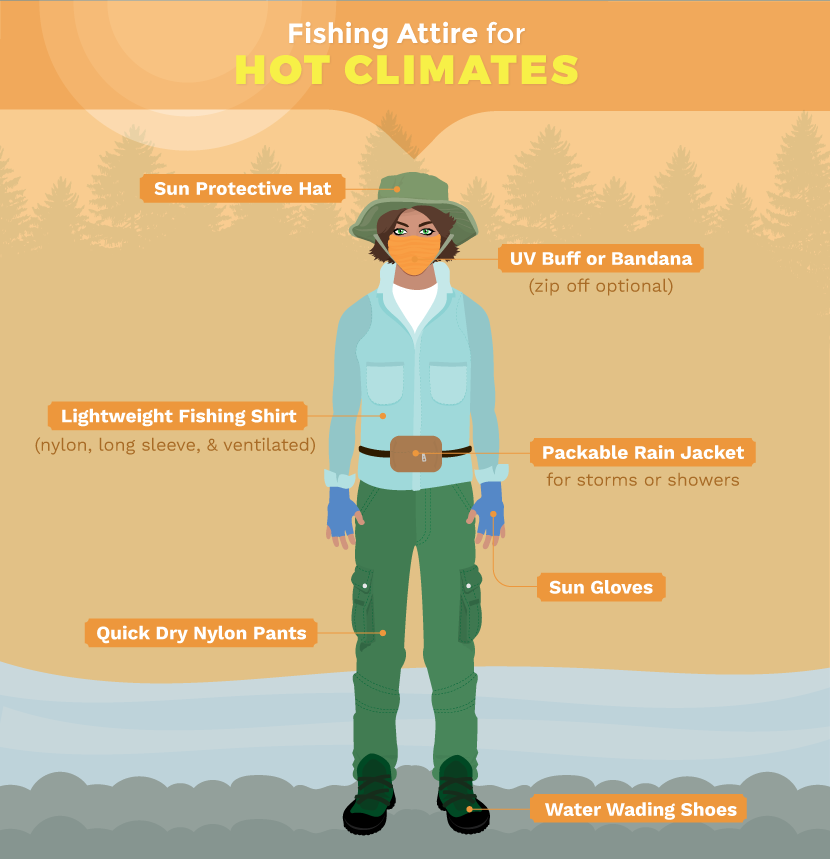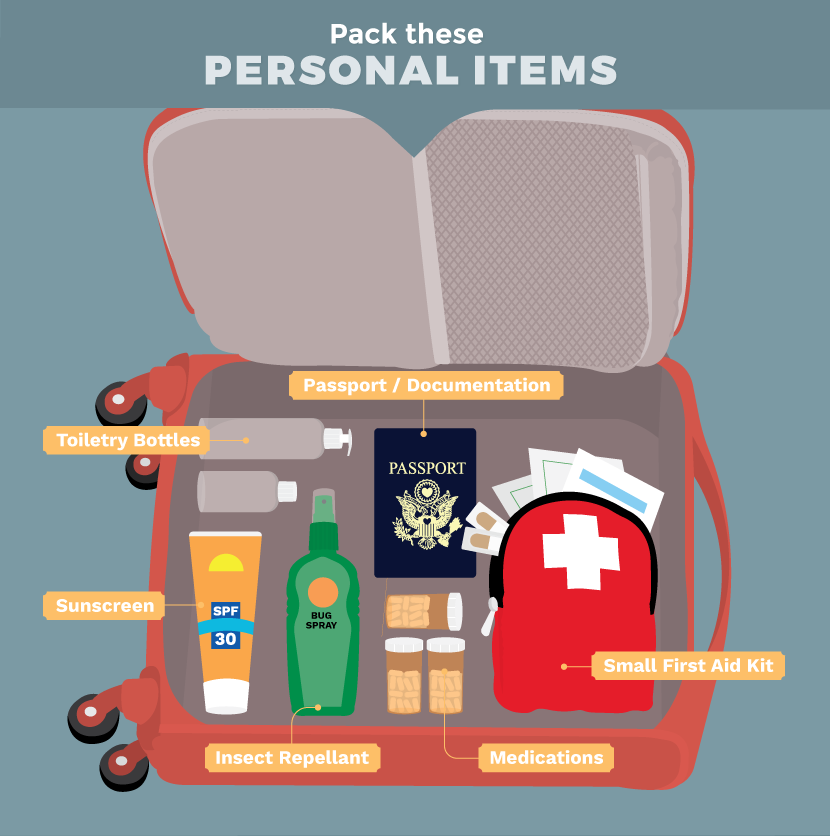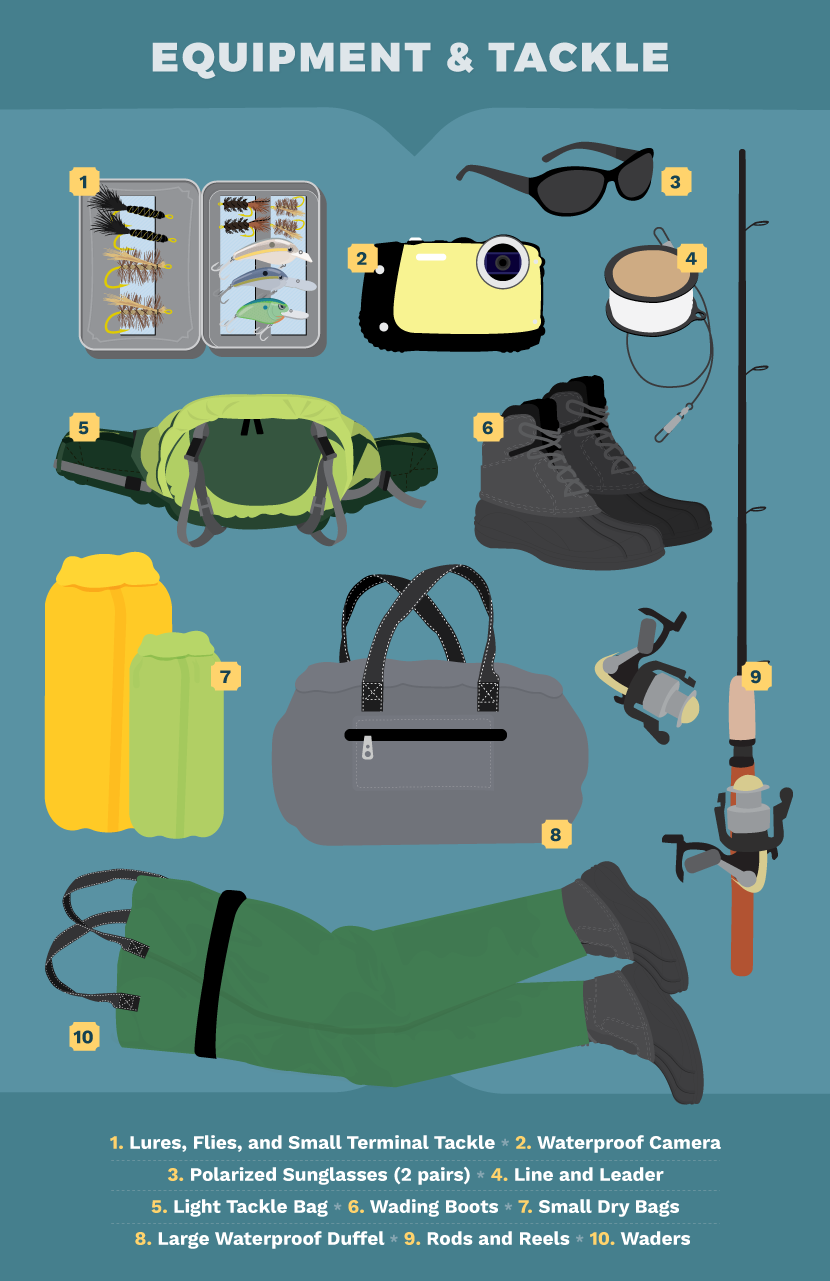Packing for a Fishing Trip
The Essentials
When preparing for a fishing adventure, packing properly is the number one thing you can do to ensure you have a great experience. Being a fly-fishing guide and industry professional allows me plenty of opportunities to travel,
and through those travels I have learned to pack efficiently by focusing on the essentials.
The following checklist can help you get organized and get the most out of your next big trip.
Clothing
Clothing is an important consideration when packing for any outdoor fishing trip. Being properly outfitted will keep you comfortable and safe, so you can enjoy your adventure.
Cold Climates
For trips to cold climates such as Alaska or Canada, it is important to choose high-quality outerwear and layering options. Don’t skimp on the waterproof clothing and make sure you bring plenty of extra underwear and socks, in case you get soaked.
The following is a list of cold-weather items I never leave on a trip without:
Quality rain gear: Buy the highest-quality gear you can afford, and that means more than just a jacket. Waterproof pants, footwear, hats, and gloves will all help keep you dry in a heavy downpour.
It is easy to get soaked during a hike to your fishing spot or a long boat ride. The right items will allow you to fish comfortably all day, even during a storm.
Wool or synthetic socks and undergarments: Make sure you bring plenty of extra socks and underwear. Even with fully waterproof outerwear, you can get soaked if you are out in the rain for extended periods.
Wool and synthetic materials will continue to keep you warm even if they get wet, and they dry quickly after the day is through.
I always bring a spare set with me in a dry bag in case I take an accidental swim. You can never have enough!
Layering pieces: In the case of really cold fishing trips, such a winter steelhead or ice fishing, it is important to layer up as much as possible.
Polar fleece is a great option that comes in a number of thicknesses or weights. At the minimum, carry a pair of sweatpants and a fleece pullover or two.
Heavy jacket: In the coldest of climates, a heavy down or synthetic jacket is a must. If there’s room in your bag, it is always worth bringing just in case there is a cold snap.
Even in temperate weather, it can be a lifesaver on a long morning boat ride or after a fall in the water.
Insulated hat and gloves: Many people don’t like to fish with gloves on, but there are many fingerless options that will keep you going when the fishing gets tough. A beanie or other insulated hat will help keep your head warm.

Warm Climates
Temperate and tropical climates can be just as demanding as cold-weather destinations. Sometimes folks traveling to warm places overlook this, assuming they can get away with shorts and a T-shirt.
With the wrong attire, spending multiple days in the sun can turn your trip of a lifetime into miserable grind. These items will help you stay comfortable during your trip:
Cool, sun-protective clothing: Fishing in warm climates often means long, hot days under direct sun. Overexposure can cause burns, exhaustion, dehydration, and even heat stroke. Make sure you cover up. Lightweight,
long-sleeved synthetic shirts with plenty of ventilation will keep you cool and keep the sun off your skin.
Team these up with a pair of rugged synthetic pants that will dry quickly if you wade in the water.
Bandanna, UV Buff, or other face protection: In the most severe climates, protecting your face is an absolute must.
I always pack some type of face covering, even if it just stays around my neck all day. As an added benefit, it can be dipped in the water to keep you cool on a hot day.
Water shoes or sandals: Good-quality wading shoes will help protect your feet and keep you from slipping on rocks when wading in lakes, rivers, or the ocean.
I prefer close-toed shoes designed specifically for wading, but if you are fishing from a boat, sandals can suffice.
Sun-protective hat: A good hat will reduce glare, allowing you to spot fish or structure under the water while protecting your face, neck, and ears from the sun. Full-brimmed hats offer superior protection to baseball-style caps.
Sun gloves: Many anglers forget to cover up their hands and end up with severe burns after a day in the sun. A pair of fingerless sun gloves is an inexpensive solution that will save your skin on an extended trip.
Packable rain jacket: Sudden storms and downpours can happen on any trip, and are quite common in many summer or tropical fishing destinations. Be prepared with a lightweight rain jacket and stay on the fish instead of running back to the lodge.

Personal Items
While having the right clothing will help keep you comfortable during your trip, stocking up on the right personal items can be just as important.
The little things are easy to overlook, so I like to make a checklist and go down it, crossing things off as I pack them:
Medications: If you take any medications, make sure to have your prescription filled well in advance and, most importantly, bring them with you in your carry-on if you are flying. You don’t want to be separated from these if your checked bags go missing.
2 oz. plastic bottles with shampoo, body wash, mouthwash, etc.: I find that purchasing clear travel bottles and filling them beforehand is far easier and less expensive than buying “travel size” containers.
Just make sure you have enough for the length of your trip.
Sunscreen: Whether you are in a cold or hot climate, always bring sunscreen. Being outside for hours on end exposes your skin to harmful UV rays, even if there is cloud cover.
Insect repellent: Bugs will ruin a trip if you let them. I typically go with 100% DEET and use it sparingly. Just a little is usually enough to keep them away.
Small first aid kit: I always carry a small emergency first aid kit with me on the water. It only has the basics, but it comes in handy for treating the inevitable cuts and scrapes, insect bites, headaches,
and other things that can come up when you are outdoors.
At minimum it should include: bandages, alcohol swabs, gauze, medical tape, pain relievers, antihistamines, and antibiotic ointment.
Passport, visas, other required documentation for international trips: The absolute worst feeling is to get to the airport or the border and realize that your documentation is sitting on your nightstand at home. Don’t let it happen! Check and recheck this item.

Equipment and Tackle
Don’t overthink this aspect of the trip. Make it easy on yourself by gathering information beforehand and focusing on the essentials for your destination, rather than trying to bring every piece of tackle you own.
Light pack: Create a “travel pack” that stays empty so you can fill it from your personal stock with essential lures, flies, and terminal tackle prior to your trip. Sling packs, chest packs, and small backpacks made specifically for fishing are great for this.
Waders and boots: Waders and boots are heavy and take up space, so I would not advise traveling with them unless absolutely necessary. If you do, it is helpful to find a lightweight,
inexpensive set that will pack away easily. Make sure to bring a big hefty bag or two to store them in if they are wet on the trip home.
Rods and reels: If possible, use gear provided by your lodge or outfitter. If you must bring your own, take only what is necessary and leave room for a spare.
Lures, flies, and terminal tackle: Check with local fly/tackle shops and outfitters for current fishing conditions and advice on what lures, flies, and techniques are working best.
Local shops are great resources that can help you narrow down exactly what you will need. Many lodges and outfitters often have equipment and flies/lures for their guests to rent or use, so check with them first!
Line and leader: Always bring spare line and leader material if you are using your own equipment.
Large, waterproof duffel bag: Pack your clothing in an oversized waterproof duffel to protect it during ferry rides, float plane transfers, or portages.
Interior dividers: Use interior dividers to organize your clothing and personal items in the bag. Keep a change of clothes and all your essential items with you in a carry-on if you are flying.
Portable camera: Pack a point-and-shoot waterproof camera and an extra memory card to capture and preserve memories from your trip. Make sure to bring your chargers, cords, and cables!
Waterproof box or dry bag: Bring a small dry bag or waterproof box for your phone, wallet, keys, etc.
2 pairs of polarized sunglasses: Polarized sunglasses protect your eyes and cut glare so you can see your fly, spot underwater structure, and even see fish. I always pack a spare, just in case I break or lose my main pair.

Preparing for a trip doesn’t need to be a chore. I consider it a part of the adventure where I get to plan and look forward to the days ahead, knowing that I will be comfortable and ready with the appropriate clothing and equipment.
I wish you the best of luck on your next adventure. You can never guarantee the fishing, but with the right preparation, you can always enjoy the experience.
Embed the article on your site

